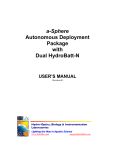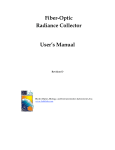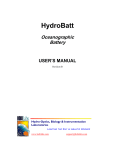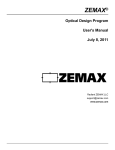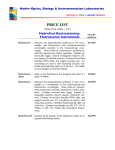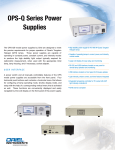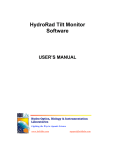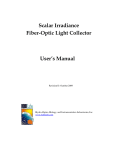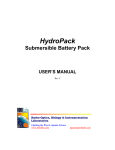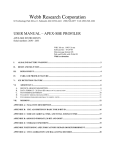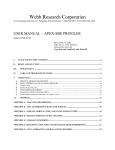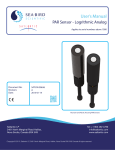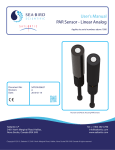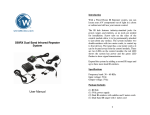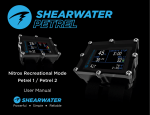Download a-Sphere-HydroBatt Package Manual
Transcript
a-Sphere Autonomous Deployment Package USER’S MANUAL Hydro-Optics, Biology & Instrumentation Laboratories Lighting the Way in Aquatic Science www.hobilabs.com [email protected] -2- 1. INTRODUCTION This manual describes an autonomous deployment package that supplements an a-Sphere in-situ spectrophotometer with two HydroBatt battery packs and a Seabird SBE-5 Pump. Detailed information about each of these system components can be found in its respective user’s manual, while this document addresses topics specific to the package and its deployment. The package is designed to allow deployment of the a-Sphere without an electrical connection to the surface. The HydroBatts provide power, and the a-Sphere logs data internally to its nonvolatile flash memory. The aSphere also provides switched power to the pump, which flows water through the a-Sphere’s sampling cavity. The frame can be lowered on any suitably strong winch cable. The a-Sphere is positioned in the frame such that its removable hemisphere is easily accessible for cleaning, either from the side of the frame, or from the end if the frame is tipped on its side. -3- 2. PRECAUTIONS AND MAINTENANCE In addition to those mentioned in the individual instrument manuals, observe the following important precautions when using the system: • Be sure all instrument retaining clamps are firmly tightened. • Always secure the a-Sphere with an additional safety line from its mounting eye to the frame. • Be sure the device housings are protected from direct contact with the metal clamps and other metal parts. • Do not run the pump dry. Use the a-Sphere switch to turn it off when the package is out of the water, or if necessary unplug it. • When connecting the battery packs to their Y-cable, plug one in immediately after the other. Once the first pack is plugged in, its voltage appears on the second connector, making it vulnerable to short circuits until that connector is plugged in. This connector is “live” with the voltage from the first battery pack. Plug it into the second pack immediately to reduce the risk of short circuits. -4- 3. DEPLOYMENT CONSIDERATIONS 3.1. Plumbing and Water Flow The frame is configured to allow very simple plumbing for the best possible water flow through the sphere. The sphere outlet should be connected to the pump inlet with a very short piece of tubing as shown at right. The inlet on the removable hemisphere should be equipped with a wire mesh strainer, also shown, to keep objects and debris from entering the sphere. 3.2. Power Conservation The a-Sphere includes sophisticated thermal control circuitry to stabilize both the light source and spectral detector, and this control can consume a substantial amount of power. The actual power consumption of the a-Sphere may vary from about 7.5 to 30 W (35 W peak) depending on ambient temperature. The highest power is required during initial warmup, and the steady-state consumption is highest when the ambient temperature is low. The lowest power is required when the ambient temperature is about 20 C. The pump requires an additional 6 to 8 W. Its consumption is directly related to flow rate, and is highest when the plumbing is kept short and direct, as we recommend, to maximize the flow. With both HydroBatts fully charged, the system will provide at least 12 hours of continuous operation, and often much longer. To maximize endurance we recommend that whenever you operate the system on deck (for example when waiting for the thermal stabilization before a cast or between casts) you connect it to an external power supply of 18 to 24 V, which will remove the load from the batteries. You can supply this external power through the PDI cable. To observe the voltage of the batteries, connect to the a-Sphere with a-Sphere Console, open the terminal window, and type VIN. This will display the actual voltage reaching the a-Sphere. It can operate with minimum input of 10 V. Keep in mind that the voltage will be somewhat higher when the pump is not running. -5- 3.3. Pump Control The pump is lubricated by water, so it should not be run dry. It is acceptable to run it for short periods out of the water as long as its impeller mechanism is wet, for example at the end of a cast when the package is being handled on deck. Similarly it can be run briefly before the beginning of a cast, provided it is thoroughly wet. If necessary, you can simply squirt water into the pump through its outlet before starting it. The a-Sphere (Series 200 and later) is equipped with a switch to start and stop logging, and this also controls the pump. However there may be circumstances, such as testing, in which it is necessary to use the switch on deck. In those cases, one can simply unplug the pump. If you do unplug the pump, be sure to include checking that connection as part of your pre-deployment routine, because immersing the system with the a-Sphere’s pump port unplugged could severely damage it. 3.4. Recommended Deployment Sequence 1. Connect an 18 to 24 V power supply to the a-Sphere through its power/data interface (PDI) cable. If the power supply voltage is lower than 16 V, leave the batteries disconnected from the a-Sphere. 2. Connect the PDI to a computer. 3. Turn on the power and monitor the thermal stabilization with the a-Sphere Console application. 4. (If necessary, squirt water into the pump to prepare it for use) 5. When the a-Sphere is stabilized and you are ready to deploy, connect the batteries to the a-Sphere (if necessary), turn off the external power supply, then start logging with the switch on the a-Sphere. 6. At the conclusion of the cast, turn off the switch on the a-Sphere as soon as it is accessible. 7. If you wish to keep the thermal regulation active until the next cast, or if you wish to offload data from the a-Sphere, connect the external power supply, turn it on, then disconnect the batteries. -6- 4. MECHANICAL PARTS AND TOOLS The individual devices rest on plastic saddles that match their diameters, and are held in place by hose clamps. Since direct contact with the metal hose clamps would damage the device cases, the bands of the hose clamps are covered with PVC tubing. Eventually the tubing and clamps may become worn and require replacement, so we list suitable parts below. The part numbers are for McMaster-Carr Supply Company, www.mcmaster.com, although equivalents are available from many other suppliers. 4.1. Replaceable Parts The hose clamps are constructed entirely of 316 stainless steel and have 5/8” bands and vibration-resistant tightening mechanisms. • HydroBatt clamps: 4-3/4” to 5-5/8” diameter range, McMaster 5682K19 • a-Sphere clamps: 7-1/4” to 8-1/8” diameter range, McMaster 5682K25 • Pump clamp: 2” to 4-1/8” diameter range, McMaster 5682K52 • Tubing: ½” internal diameter, 1/16” wall flexible PVC, McMaster 5231K88 The machined plastic saddles are held to the frame with ¼-20 x ¾” flat head 316 stainless steel screws. The pump is also protected against direct clamping pressure by a rigid stainless steel clamp with a plastic insert, McMaster 11355T73. These parts should not normally need to be replaced. 4.2. • Tools The hose clamps are tightened with a 5/16” socket or nut driver, or a flat-head screwdriver. -7-







